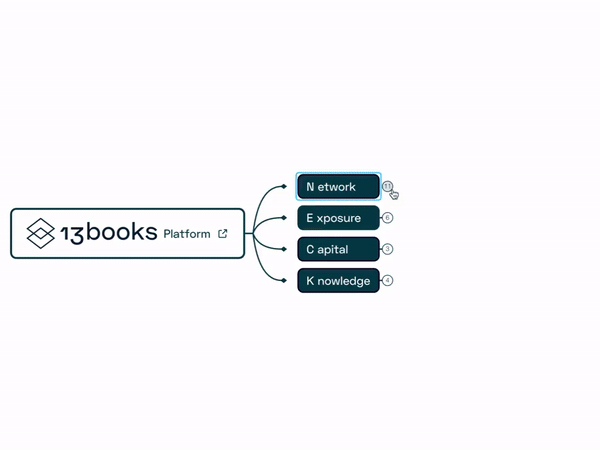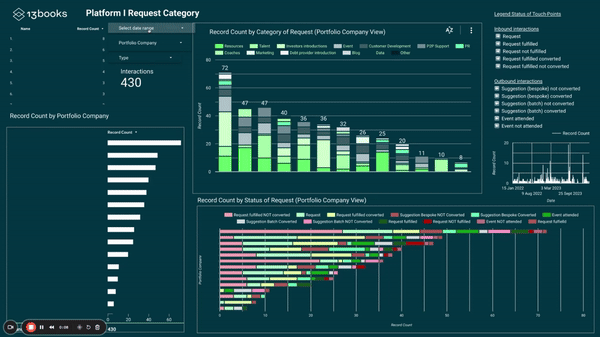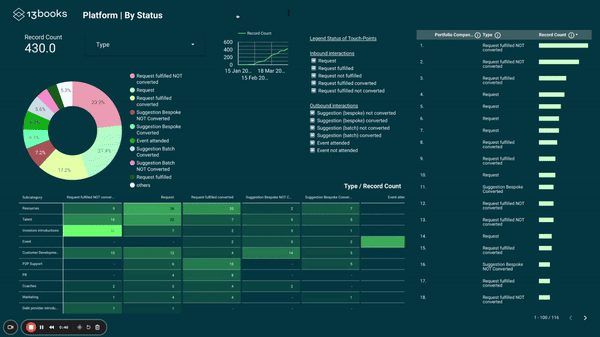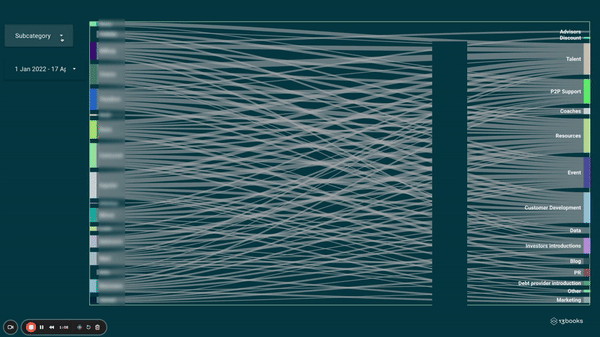Establishing a Direction
Once I’d considered the challenges ahead, the first step I took to set up a platform function at 13books was to decide on a direction. Over the first twelve months, I recorded public interactions between the team and our portfolio companies. I also analysed communications across the venture capital network, thanks to a few fantastic tailored communities catered to platform professionals on platforms such as Slack and WhatsApp (shout out to Global Platform Community) noting recurring recommendations and FAQs. By studying behaviours and patterns, both internally and externally, I was able to extract some key themes of requests that required attention.
I then proceeded to group those requests into four main categories – Network, Exposure, Capital and Knowledge (NECK), which I later broke down further into subcategories. Network, for example, can be broken down into the following subcategories: Peer-to-Peer support, Talent, Customer Development and Investor Introductions. This exercise and framework revealed the questions that appeared most within particular work streams and presented the lowest hanging fruit. And just like that, we had our focus areas for the next three to six months laid out in front of us. My next task was to take those findings and make the platform more proactive – I proceeded to develop frameworks to drive and double down on future activity.

NECK framework where N stands for Network which includes Peer-to-Peer support, Advisors, Talent, Customer development (mainly introductions to potential customers), Investor introductions, E stands for Exposure which encompasses Events, PR and Marketing, C which stands for Capital which covers an obvious one and investment and lastly, K which represents Knowledge that covers Resources and Data (still work in progress but coming soon).
While this unique framework set us into motion, a challenge arose – the dashboard below each company had a relatively high ratio of requests about broadly refined resources. To address this, I developed a list of providers with custom filters, which narrowed them down by product, location, size, price, internal score, which portfolio companies have used or worked with the them, which of them we have recommend to them. With resource requests met and filtered out, the dashboard offered a focused glimpse into key metrics, showing us data like which of our portfolio companies were most active, the frequency of incoming requests, and which topics we were being asked about the most. Easy visualisation of this data allowed us to communicate to our stakeholders what Platform at 13books could offer – or more importantly, what it does not offer.
Understanding Stakeholders
While building 13books’ Platform function from scratch has come with many valuable takeaways, there is one standout learning that I believe takes the cake: you must always make sure to understand the needs of your stakeholders and search for synergies among their needs.
When you’re in a Platform role, you are expected to balance three main stakeholders: portfolio companies, LPs and your internal team. To understand and address the needs and synergies of each stakeholder, I use a triangulation tool. Doing so allowed me to cross-check which, and to what extent, stakeholders would be affected by the activities I decided to focus on. I also leveraged the use of small events to gather the unique and relevant expertise of our LPs. These tools provided insights into our portfolio companies and allowed them to meet other founders while exposing our LPs to the founders and our team. In the meantime, all of this collected data fed right back into the dashboard, showing the tangible touch-points created and results of the activities we decided to prioritise.

Platform Pulse tracks touch-points with portfolio companies
It is important that you further track the lifecycle of each portfolio company, designing desired touch-points for distinct phases. At 13books, we broke those phases down into three main stages: Activated (roughly 3-6 months from investment), Embedded (next 7-12 months) and Exit (12+months). Mapping requests, interactions and activities of each portfolio company will provide insights into their progress and needs over time.

Platform Pulse filtering by status.
The metrics collected will not only assist with decision-making and resource allocation, but they will help identify opportunities for collaboration between stakeholders. Moreover, this framework allows for a transparent feedback loop with our stakeholders – by sharing concise and data-driven information about how we’ve supported them and in which capacity that support has proved to be beneficial (to the point of conversion!) all stakeholders, ourselves included, are empowered to communicate openly and effectively.
As we continue to experiment with proxy metrics, I recognise that there is an ongoing balancing act between the Bespoke and the Batch “Product” approach to how we interact with our network. From engaging in events to curating or interacting with content to stakeholder introductions, we are keen to keep playing around to find out what works best in various stages and scenarios. Stay tuned and open to suggestions!

Secrets for Success
When it comes to setting up a Platform function from scratch, it is clear that there is no secret formula – but there are certainly some tried and tested frameworks you can instil to set yourself up for success. VCs, in particular, often present certain expected challenges, like volume and lack of repeatability, which can seemingly slow down your progress, but remember that proactivity can go a long way, and that your Platform role holds some serious value for the firm.
With an innovative decision-making process, a clear direction for your platform and an informed understanding of your stakeholders, you will be well on your way to establishing an effective platform which – most importantly – prioritises the needs of your portfolio companies.
We hope you enjoyed our two-part series ‘How to set up a VC platform from scratch’. And don’t forget, if you’d like to find out more from Joanna, contact her via LinkedIn. She’d love to hear from you!